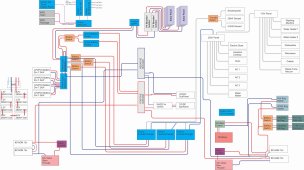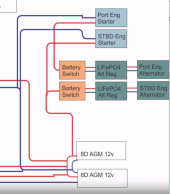Hello. I know there is a lot of different threads trying to discuss this, but unfortunately none seem to fit my need close enough. I have a 65' power boat. It has two engines for prop power, smaller generators on them. It had one 20kw generator and one 5kw generator. Engine room is midship, and has bow and stern thrusters. The stern thruster, along with the batteries, are in the aft cabin. Bow thruster batteries are in the engine room.
All batteries need replacing. The engines and bow thruster I will run off of two 8d agm batteries. The stern thruster requires the same. Unless anybody has a better idea for this. The ship is 100tons, so the thrusters are a bit large.
Due to the need to take this on a 6000 mile journey, and just completing another 2000 mile journey on a different boat (52', 16kw generator and 2 MTU 900HP engines) I own where I had to run the generator nearly constantly, I have decided to make this boat much more self-sufficient for this journey.
I intend to add flexible solar panels to my hard bimini (16' x12') top (any good recommendations from aliexpress would be great). Also looking to perhaps add a wind generator. But looking to also add in ~20kw (+/- 5kw) worth of LiFePO4 battery banks (not looking to build from cells).
So my question is help with some of the suppliers, and any help with design considerations given I plan to have solar, wind, two different generators, plus AGm and LiFePO4 batteries.
I am sure I am missing out on a ton of details you will need to provide some feedback, but anything would be great!
Thank you in advance.
All batteries need replacing. The engines and bow thruster I will run off of two 8d agm batteries. The stern thruster requires the same. Unless anybody has a better idea for this. The ship is 100tons, so the thrusters are a bit large.
Due to the need to take this on a 6000 mile journey, and just completing another 2000 mile journey on a different boat (52', 16kw generator and 2 MTU 900HP engines) I own where I had to run the generator nearly constantly, I have decided to make this boat much more self-sufficient for this journey.
I intend to add flexible solar panels to my hard bimini (16' x12') top (any good recommendations from aliexpress would be great). Also looking to perhaps add a wind generator. But looking to also add in ~20kw (+/- 5kw) worth of LiFePO4 battery banks (not looking to build from cells).
So my question is help with some of the suppliers, and any help with design considerations given I plan to have solar, wind, two different generators, plus AGm and LiFePO4 batteries.
I am sure I am missing out on a ton of details you will need to provide some feedback, but anything would be great!
Thank you in advance.




